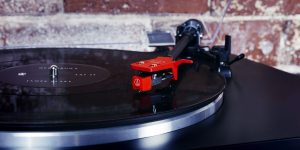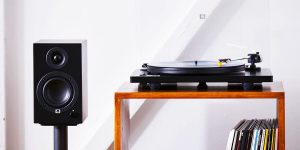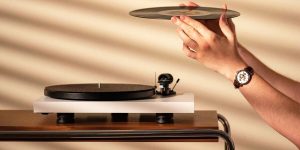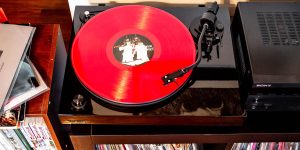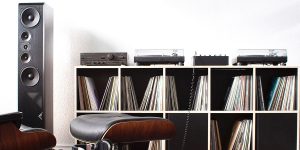As vinyl’s popularity soars, the choice between belt-drive and direct-drive turntables has become a serious consideration for those seeking the ultimate vinyl playback experience. In this article, I will compare belt-drive vs direct-drive turntable, exploring their pros and cons, aiming to equip you with the knowledge necessary to make a decision in your pursuit of vinyl perfection.
What belt-drive turntable is
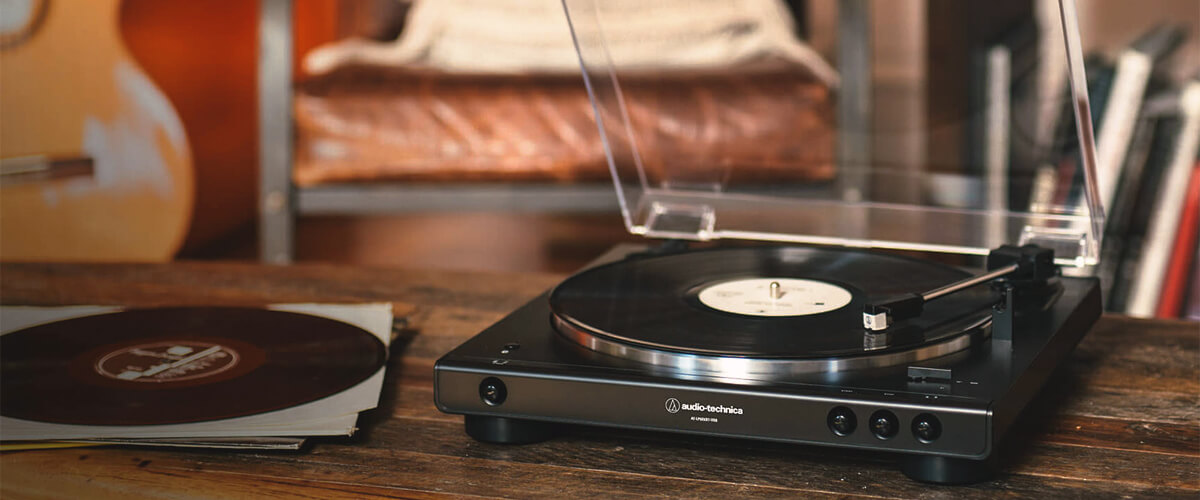
These are a classic and popular type of turntable known for their distinct features and advantages. The primary feature of a belt driven turntable is the motor’s placement away from the platter. A rubber belt connects the motor to the platter’s spindle. This design isolates the platter from motor vibrations, reducing noise and ensuring smoother rotation.
Considering for and against belt-drive turntable
Reduced vibration and better sound quality: As mentioned earlier, the belt-drive mechanism isolates the motor from the platter, resulting in reduced vibration and motor noise transmission. This isolation helps in achieving better sound quality, with cleaner and more accurate audio reproduction.
Easy maintenance and replacement: A turntable with drive belt is generally easier to maintain and replace parts compared to direct-drive turntables. The belt itself is a consumable part and can be easily replaced when it wears out or stretches over time. Additionally, the separate motor design makes servicing and maintenance more straightforward, contributing to the longevity of the turntable.
Affordable options available: They often come in a wide range of price points, making them accessible to a broader audience. From entry-level models for beginners to high-end audiophile-grade options, consumers can find belt-drive turntables that fit their budget and requirements.
While belt-drive turntables have really great advantages, they also come with some limitations. Here are some of the cons associated with belt-drive turntables:
- Slower start-up and speed adjustment: The belt needs to engage the platter, which can take a few seconds before the turntable reaches its full speed. Additionally, adjusting the rotational speed (RPM) of the platter can be a bit more cumbersome in belt-drive turntables than in direct-drive turntables, where speed adjustment is usually more immediate and precise.
- Belt wear and eventual replacement: With regular use, the belt can stretch or degrade, affecting the turntable’s accuracy in maintaining the correct rotational speed. Eventually, the belt will need to be replaced to maintain optimal performance.
- Less suited for DJing and scratching: DJs and scratch artists often require instant and precise speed control, which is better achieved with direct-drive turntables. The belt-drive design can also be more susceptible to speed fluctuations when subjected to the quick and forceful movements involved in DJing and scratching, making it challenging to maintain stable playback during these actions.
Determination of direct-drive turntable
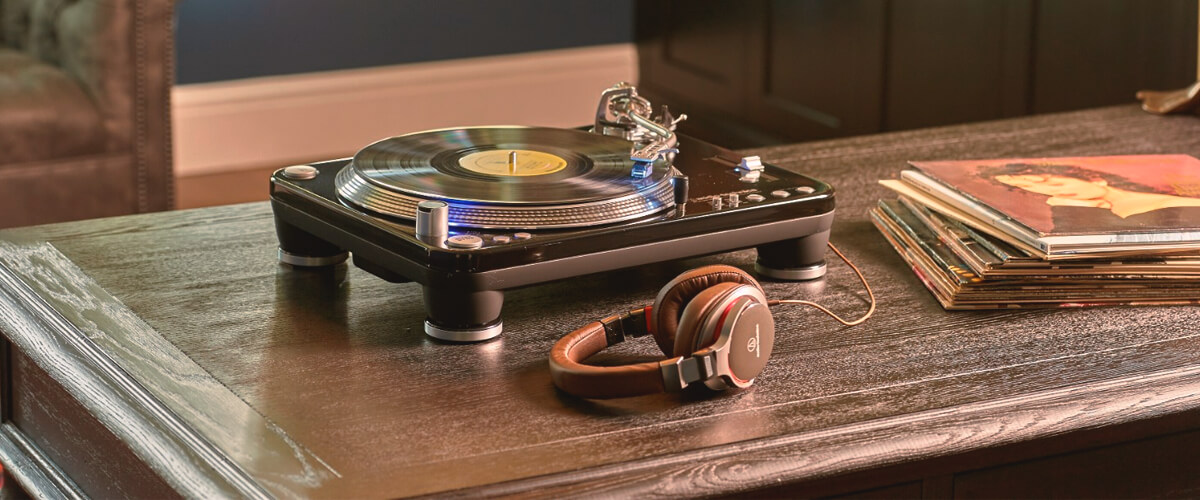
The motor in this type of turntable is directly connected to the platter’s spindle, eliminating the need for a belt to transfer power. This design results in several distinct peculiarities and advantages.
Advantages of direct-drive record players
Faster start-up and accurate speed control: They reach their full rotational speed almost instantly when powered on. This quick start-up is especially advantageous for DJs and anyone who wants immediate playback without any delays.
Greater durability and stability: The direct-drive mechanism eliminates the need for a rubber belt, reducing the chances of wear and tear associated with belt-driven turntables. The absence of a belt also means one less component to replace over time. Moreover, direct-drive turntables are generally more robust and resistant to external vibrations, providing greater stability during playback, which is crucial for precise sound reproduction.
Ideal for DJing and professional use: Direct-drive turntables are the go-to choice for DJs and professional audio applications. Their ability to quickly adjust and maintain rotational speed is essential for beatmatching, mixing, and scratching. The higher torque offered by direct-drive turntables ensures that the platter resists slowing down or speeding up when manipulated, allowing DJs to perform intricate scratching techniques with ease and precision.
Indeed, direct-drive turntables also come with a set of drawbacks. Here are some of the cons associated with them:
- Potential for increased vibration and noise: Direct-drive turntables have the motor directly coupled to the platter, which can lead to increased mechanical vibrations and noise. While modern turntables are designed to minimize these issues, they may still be more susceptible to motor noise compared to belt-drive turntables.
- Higher price range: The direct-drive mechanism requires more precision engineering and quality components, which contributes to the higher price point.
- More complex maintenance and repairs: Direct-drive turntables have a more intricate internal structure due to the direct coupling between the motor and the platter. Repairing or servicing direct-drive turntables may require specialized knowledge or professional assistance, adding to the overall cost of ownership.
Choosing the ideal turntable that suits your needs
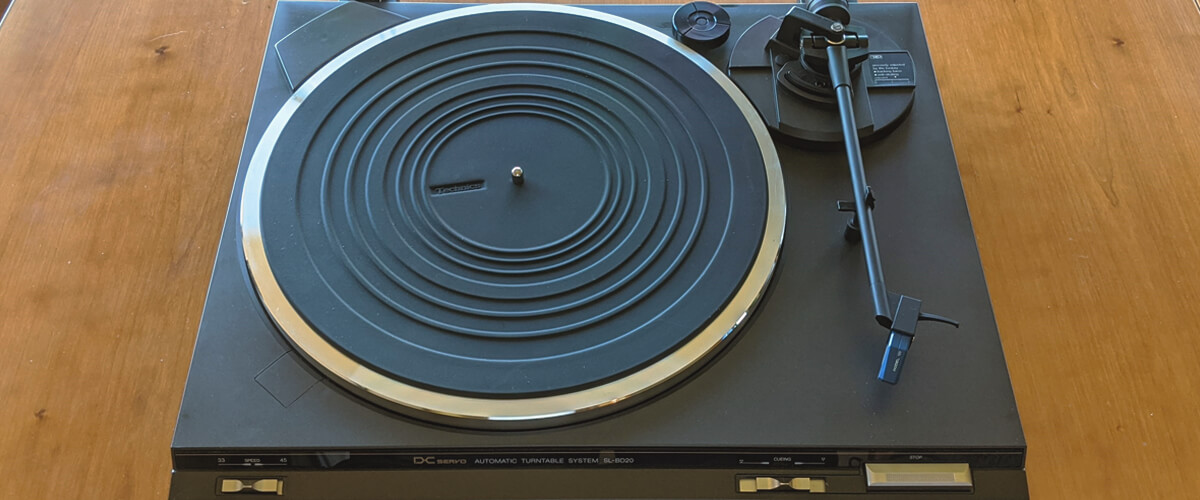
It’s essential to consider various factors to ensure that the turntable meets your specific needs and preferences. Realizing the difference between direct-drive and belt-drive is required to come up with the right choice. When choosing the right turntable, keep in mind some of the key points I’ve outlined below.
Evaluating your requirements and usage
Different turntables cater to various preferences and purposes. I suggest you explore the next two scenarios.
Casual listening. For individuals who primarily want to enjoy their vinyl collection at home and value affordability and sound quality, a belt-drive turntable is a well-suited choice. Such models are known for their smooth and quiet operation, with reduced motor noise and vibrations. These TTs are easy to use and require minimal maintenance, which is ideal for relaxed and hassle-free vinyl playback at home.
DJing and audiophile listening quality. Direct-drive turntables are known for their high torque motors, providing quick start-up and stop times. As I’ve said before, this feature is essential for DJs who need precise and rapid manipulation of vinyl playback for beatmatching and seamless mixes.
Moreover, they offer stable speed control, ensuring accurate and consistent rotation speeds, essential for maintaining precise pitch and timing during DJ performances. They are also more durable and can withstand the rigors of frequent use in professional settings.
And if you want to get the highest quality sound so that you don’t miss a single musical detail, then direct drive models will be the optimal option for you.
Considering your financial constraints
When evaluating your budget for a turntable, it’s essential to consider both the initial cost and long-term maintenance expenses. Turntables come in various price ranges, and understanding the cost implications can help you make a decision. In this context, it’s worth comparing the price range when you don’t know whether to choose direct drive or belt drive turntable.
Belt-drive turntables are known for their affordability and often fall within a lower price range. On the other hand, direct-drive turntables are more expensive. This is due to their advanced features, such as high torque motors, stable speed control, suitability for DJing, and audiophile-quality sound.
While considering the initial cost is important, it’s equally crucial to factor in long-term maintenance expenses. Belt-drive turntables generally have lower maintenance costs. Direct-drive turntables offer greater durability, but their maintenance expenses may be slightly higher. Some direct-drive turntables have sophisticated internal components that may require occasional servicing or adjustments to maintain optimal performance.
Audio fidelity and overall performance
The drive system is a critical factor in determining the sound quality of a turntable. It directly influences vibration reduction, pitch stability, and noise levels during vinyl playback. Both belt-drive and direct-drive turntables have unique advantages and drawbacks in these aspects, which can significantly impact the audio experience.
Belt-drive turntables excel in reducing motor noise and vibrations and generally offer good pitch stability, ensuring accurate and consistent rotation speeds. Due to the motor isolation, belt-drive turntables tend to exhibit lower noise levels, allowing the music to shine without interference. Some belt-drive turntables may have lower torque compared to direct-drive models. This limitation can affect start-up times and might not be ideal for DJing or other applications requiring rapid manipulation.
As for direct-drive turntables, they have improved vibration reduction in this aspect over the years, with modern designs incorporating vibration-reducing technologies. Direct-drive turntables are renowned for their excellent pitch stability. The direct connection between the motor and platter ensures precise and consistent rotation speeds, vital for accurate pitch and timing during playback. Direct-drive turntables tend to have slightly higher noise levels compared to belt-drive models. However, advancements in design have significantly reduced motor noise in modern direct-drive TTs.
When considering sound quality, it’s important to look beyond the drive system and consider other factors contributing to the overall performance:
- Turntable components: High-quality components, such as tonearms, cartridges, and stylus, are important for sound reproduction. Investing in well-engineered components can make a substantial difference in audio fidelity.
- Build quality: A sturdy and well-built turntable helps minimize internal vibrations and resonances, contributing to more precise and more accurate sound.
- Isolation from external vibrations: Isolating the turntable from external vibrations is essential to prevent unwanted interference with the audio playback. Proper isolation helps maintain stable rotation and reduces the risk of skipping or tracking issues.
We are supported by our audience. When you purchase through links on our site, we may earn an affiliate commission at no extra cost to you.
Our newsletter
* We will never send you spam or share your email with third parties

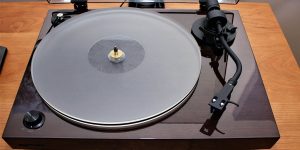

![Best Turntables Under $100 [Reviewed and Tested]](https://righttechadvice.com/wp-content/uploads/2023/09/best-turntable-under-100-300x150.jpg)
![Best Turntables Under $300 [Reviewed and Tested]](https://righttechadvice.com/wp-content/uploads/2023/10/best-turntable-under-300-review-300x150.jpg)
![Best Record Players Under $200 [Reviewed and Tested]](https://righttechadvice.com/wp-content/uploads/2023/10/best-turntable-under-200-300x150.jpg)

